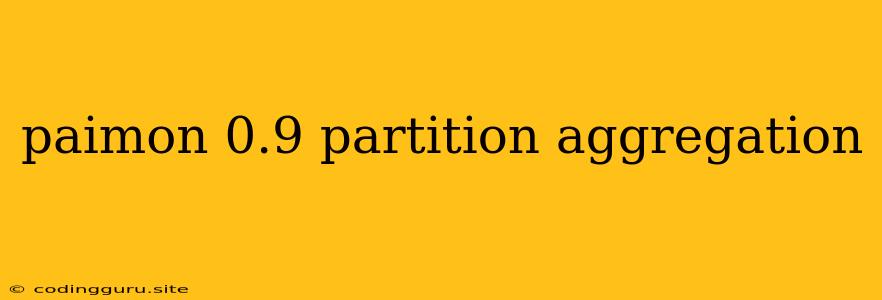Understanding Paimon 0.9: Partition Aggregation for Optimized Data Processing
Paimon 0.9 marks a significant milestone in data processing with the introduction of partition aggregation. This powerful feature allows for highly optimized query execution by combining data from multiple partitions into a single aggregated result, effectively reducing the amount of data that needs to be processed and scanned.
But what exactly is partition aggregation and how does it benefit data processing?
Let's break it down:
What is Partition Aggregation?
In a nutshell, partition aggregation is a technique used in Paimon to optimize query execution by combining data from multiple partitions into a single aggregated result. This aggregation is performed before the actual query execution, allowing Paimon to efficiently process only the aggregated data, resulting in significant performance gains.
How does Partition Aggregation Work?
Imagine a scenario where you have a large table partitioned by date. You want to calculate the total sales for each product across all dates.
Without partition aggregation, Paimon would have to scan all partitions for each product, potentially leading to a lot of unnecessary data processing.
With partition aggregation, Paimon performs the following steps:
- Identify the partitions: The query optimizer determines which partitions contain the necessary data based on the query conditions.
- Aggregate data: The data within each partition is aggregated based on the query's aggregation function (e.g., sum, average, count).
- Combine aggregated results: The aggregated results from each partition are then combined into a single final result.
By aggregating data at the partition level, Paimon reduces the amount of data that needs to be processed and scanned, leading to significantly faster query execution times.
Advantages of Partition Aggregation:
- Improved Query Performance: Reduced data scanning and processing leads to faster query results.
- Reduced Resource Utilization: Less data processing means less CPU and memory utilization.
- Simplified Data Management: Aggregating data at the partition level simplifies data management and reduces the need for complex data structures.
Using Partition Aggregation in Paimon:
To leverage partition aggregation in your Paimon queries, ensure your table schema and partitioning strategy support it.
Consider these key points:
- Partitioning Key: Choose a partitioning key that aligns with your common query patterns. For example, partitioning by date or product ID can be highly effective.
- Aggregation Function: The aggregation function you use in your query should match the desired outcome. Common aggregation functions include
sum,avg,count,min, andmax.
Example:
Let's assume you have a sales table partitioned by date with columns product_id, date, and amount.
To calculate the total sales for each product across all dates, you can write a query like this:
SELECT product_id, SUM(amount) AS total_sales
FROM sales
GROUP BY product_id;
Paimon will automatically apply partition aggregation to this query, aggregating the amount column at the partition level before performing the final grouping and aggregation.
Conclusion
Partition aggregation in Paimon 0.9 provides a powerful mechanism to optimize query performance and reduce resource utilization. By leveraging this feature, you can achieve significant efficiency gains and ensure fast and reliable data processing. As you design your data models and query strategies, consider incorporating partition aggregation to unlock the full potential of Paimon for your data processing needs.
